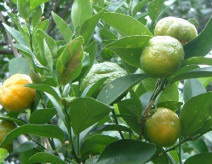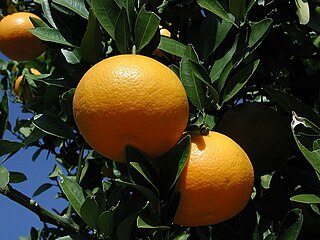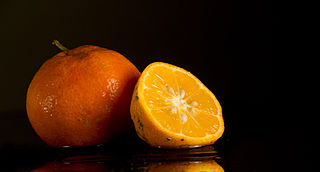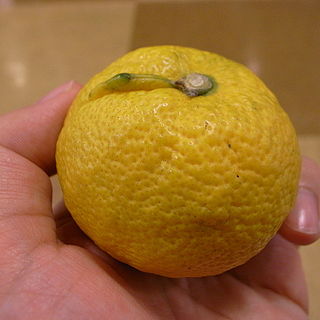
A mandarin orange, often simply called mandarin, is a small, rounded citrus tree fruit. Treated as a distinct species of orange, it is usually eaten plain or in fruit salads. The mandarin is small and oblate, unlike the roughly spherical sweet orange. The taste is sweeter and stronger than the common orange. A ripe mandarin orange is firm to slightly soft, heavy for its size, and pebbly-skinned. The peel is thin and loose, with little white mesocarp, so they are usually easier to peel and to split into segments. Hybrids have these traits to lesser degrees. The mandarin orange is tender and is damaged easily by cold. It can be grown in tropical and subtropical areas.

The tangelo, Citrus × tangelo, is a citrus fruit hybrid of a Citrus reticulata variety, such as mandarin orange or tangerine, and a Citrus maxima variety, such as a pomelo or grapefruit. The name is a portmanteau of 'tangerine' and 'pomelo'.

Citrus unshiu is a semi-seedless and easy-peeling citrus species, also known as the satsuma mandarin or Japanese mandarin. During the Edo period of Japan, kishu mikans were more popular because there was a popular superstition that eating Citrus unshiu without seeds made people prone to infertility. Citrus unshiu became popular in Japan after modernization started in the Meiji period. It was introduced to the West from the Satsuma region of Japan in 1878.

Sudachi is a small, round, green citrus fruit of Japanese origin that is a specialty of Tokushima Prefecture in Japan. Harvested before it fully ripens to yellow, it is tart and not eaten as a table fruit but used to flavor sauces and marinades, desserts, and drinks in place of lemon or lime. Genetic analysis shows it to be the product of a cross between a yuzu and another citrus fruit akin to the koji and tachibana orange.

Citrus depressa (Citrus × depressa, formerly C. pectinifera, Okinawan: シークヮーサー/シークァーサー, romanized: shiikwaasa, Japanese: ヒラミレモン, romanized: hirami remon or シークヮーサー, shiikwāsā, in English sometimes called shiikuwasha, shequasar, Taiwan tangerine, Okinawa lime, flat lemon, hirami lemon, or thin-skinned flat lemon, is a small citrus fruit often harvested and used when green, rich in flavonoids and native to East Asia.

The tangor is a citrus fruit hybrid of the mandarin orange and the sweet orange. The name "tangor" is a formation from the "tang" of tangerine and the "or" of "orange." Also called the temple orange, its thick rind is easy to peel and its bright orange pulp is sour-sweet and full-flavoured.

The iyokan, also known as anadomikan (穴門みかん) and Gokaku no Iyokan, is a Japanese citrus fruit, similar in appearance to a mandarin orange, with Dancy as the pollen parent and Kaikokan as the seed parent. It is the second most widely produced citrus fruit in Japan after the satsuma mandarin. Ehime Prefecture accounted for 90% of Iyokan production in 2021.

The mandarinquat, also misleadingly called orangequat, is any cross between a mandarin and a kumquat. Mandarinquats are members of the citrofortunella group.

Rangpur, Citrus × limonia or Citrus reticulata × medica, sometimes called the rangpur lime, mandarin lime or lemandarin, is a hybrid between the mandarin orange and the citron. It is a citrus fruit with a very acidic taste and an orange peel and flesh.

Japanese citrus fruits were first mentioned in the Kojiki and Nihonshoki, compiled in the 700s, and the Man'yōshū and Kokin Wakashū, poetry anthologies compiled in the 700s and 900s, mention the Tachibana orange as a subject of waka poetry and describe its use as a medicinal, ornamental, and incense plant.

The kishu mikan, from Japanese Kishū mikan (紀州蜜柑), is a hybrid variety of mikan, or mandarin orange, found in Southern China and also grown in Japan.

Setoka is a seedless and highly sweet Japanese citrus fruit that is a tangor, a hybrid of the Murcott tangor with "Kuchinotsu No.37", which in turn is a hybrid of the Kiyomi tangor and a King tangor/Willowleaf mandarin cross, "Encore No. 2". It was registered as "Tangor Nōrin No.8" in 1998 and as "Variety registration No.9398" under the Plant Variety Protection and Seed Act in 2001. It weighs 200–280 g (7.1–9.9 oz) and has an oblate shape. The rind is thin and easily peelable. Its flavor is pleasant, aromatic, and similar to the Murcott. The fruit ripens in February. Its sugar level is very high at 12–13 °Bx whereas its citric acid is low (0.8–1.0%).

Reikou is a cultivar of tangor. It is a citrus hybrid of a hybrid of Kiyomi and Encore and Murcott tangor.

Jabara is a hybrid species of plant and fruit that is among the Japanese citrus.

Hassaku, Citrus × hassaku, is a Japanese citrus hybrid between pomelo and mandarin, with pomelo-like characteristics. The original plant was discovered near the Jyoudo temple in Inno-shima, Hiroshima prefecture, Japan.
Procimequat is a triploid citrus hybrid or transgeneric hybrid, x Fortunella hindsii, in which the limequat that itself is a cross between lime and a round kumquat, was backcrossed with the primitive Hong Kong kumquat.

The Murcott is a tangor, or mandarin–sweet orange hybrid.
Neurogenesis is the process by which nervous system cells, the neurons, are produced by neural stem cells (NSCs). This occurs in all species of animals except the porifera (sponges) and placozoans. Types of NSCs include neuroepithelial cells (NECs), radial glial cells (RGCs), basal progenitors (BPs), intermediate neuronal precursors (INPs), subventricular zone astrocytes, and subgranular zone radial astrocytes, among others.

Koji orange, also known as the smooth-fruited orange, is a Citrus species native to Japan. The specific epithet (leiocarpa) comes from the Greek λεῖοςleîos'smooth', and καρπόςkarpós'fruit'. It is a taxonomical synonym of Citrus aurantium.

Haruka is a Citrus cultivar grown in Japan and the Korean Peninsula.




















